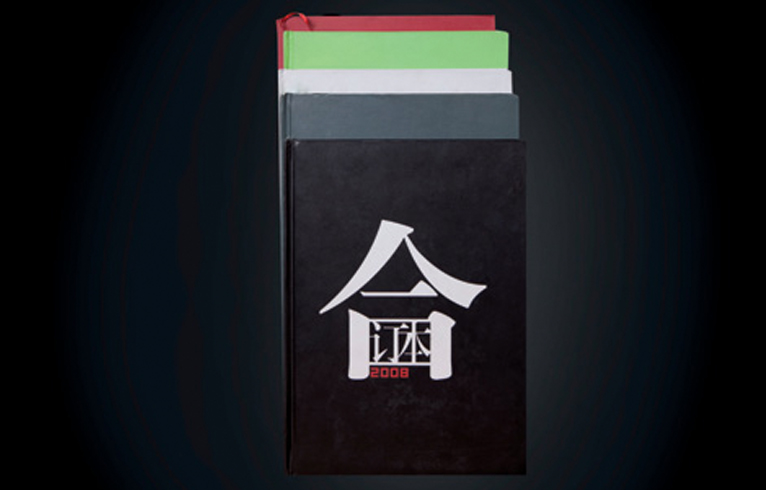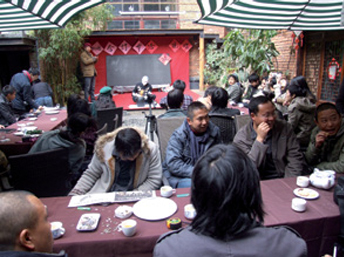BINDER RESOLUTION
| October 6, 2011 | Post In LEAP 10

ACCORDING TO THE official documentation that initiated the “Binder HQ” project— dated December 29, 2006 and directed at the artists of Kunming— the tenets of “Project Binder” were as follows: participating artists would pay a small fee of RMB 100 and contribute content in the form of 101 sets of four to ten pages, bearing the printing costs on their own; Binder HQ was responsible for taking the sheets of A4 paper (ISO216 standard A4, one-sixteenth of a square meter when opened to its full size of 210 x 297 mm) and binding them in the order provided into one hundred separate books that would be known as “The Binders.” The 101st set would be framed, and, coinciding with the release of The Binders, exhibited as (appropriately enough) “The Binder.” The project is now in its fifth year.
With the technical standard of A4 size as their only set precondition, the participating artists were free to let their imaginations run wild. For He Libin’s Time’s Dust, the artist placed dust and incense ash collected from her workshop and a nearby temple between the hours of five and six-thirty p.m. on January 4, 2011, into 101 small bags, each clearly labeled with the specific time of collection. Then there were artists like Raoul Muller, who inquired into the nature of paper as a medium by building links between paper and other materials and thus establishing a kind of dialogue. Liu Lifen returned to the hand-crafted nature of paper by attempting to reinject life with a shot of clumsy, childlike joy, while some artists, while sticking with the A4 size standard, abandoned paper altogether, as in Yin Yanhua’s use of transparent materials in his work Cube.
The Binder achieves conceptual radicality despite its extremely conservative outward form. This core spatial constraint paradoxically allowed for a certain freedom, as the absolute consistency of the A4 form allowed artists to reproduce works which originally appeared in other venues, sizes, and formats, while still preserving their individual independence. For them this was not a limitation; on the contrary, it was precisely this kind of graphic medium— as well as other information-based alternative forms of knowledge diffusion— that made the occurrence and transmission of art history possible. This paper bias has led worldwide to a situation where conventionally important artistic notions like “venue” and “completed work” seem to lack sincerity when compared with it and the mandatory “two-dimensionalization” that accompanies it.

Upon cursory examination, it would be easy to classify The Binder and “The Binder” (especially the latter) as the product of an urge to exhaustively document a particular place and time in history. Were that the case, though, the project would need to have a historical focus, it would need to be documentary in nature, and it would need to seek the reconstruction and recovery of the scene as it actually occurred. “The Binder” is none of these. Instead, it seems more concerned with addressing the self and its context, as well as with ridiculing the very idea that a moment in history can be captured in its entirety.
Since the project’s inception in 2007, all of the participants and their collaborators have been captured together in a group photo taken from the front, then taken again from behind, the left, and the right. The effect is not unlike a group mugshot. The formal name for this symbolically potent “mugshot” is Group Portrait: Young Artists and Kunming. The group photo actually predates its marriage with “The Binder” by three years. In a temporal sense, it could be said to be the conceptual and practical prototype for “The Binder.” In an environment where the stimulation and encroachment of pressure (both systemic and from a scarcity of resources) has spawned an art world that with each passing day becomes more conceptual and marketdriven, it is apparent that the artists of Kunming would prefer to maintain their link with the flow of time and with the experience of the everyday. Rather than “conceptual,” these attempts of theirs— perhaps insufficiently grandiose, or even crass— are better described as the end result of a kind of “butterfly effect” born of the action of practice on concept: the academic air about “The Binder” has its roots in the humorous and gently satirical tone of Group Portrait: Young Artists and Kunming, which was itself no more than the product of some artists getting together for a lark.
The real subtext of “The Binder” is less about the actual artistic possibilities offered by a standard sheet of paper than it is about what it means to exist as an artist outside the metropolitan mainstream, out in “the wilds” of China’s smaller cities. On a playing field unevenly slanted towards the first-tier cities of Beijing and Shanghai, where there is a preponderance of academic and financial resources, artists in second- and third-tier cities are either forced to move to the first tier, or to self-identify with the mainstream designation of their current cities, consciously or unconsciously assuming a “second-tier” intellectual and cultural postion. If there were any other option, it might perhaps be that presented by “The Binder”: to actively transform the political, regional, and economically marginal context of one’s self and one’s city into a stance that emphasizes one’s “non-centrality,” a stance that preserves, to the extent possible, one’s “wildness,” consciously staying outside the breeding ground of mainstream contemporary art.
In the end, there is no need for us to guard against misinterpretation of the questions “The Binder” raises or their value, and no reason for us to assiduously deconstruct some of its more slapdash or half-baked works. Because in the Sisyphean battle that is art, there will always be those stalemated forces that eventually end up pointing us in diametrically opposed directions, contradiction stacked upon contradiction; that, perhaps, is the most valuable thing art has to offer.

